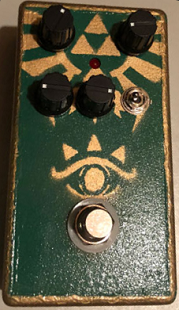Envelope Filter Fixed Wah
The BYOC Envelope Filter Fixed Wah pedal is a pretty interesting beast. Its closest relative is probably the discontinued MXR Q-Zone. The Q-Zone replicates the sound of a wah-wah pedal that's been turned on, but left with the treadle in a location on the sweep which provides a sort of nasally-sounding tone. Many people associate this sound as the signature Michael Schencker sound. Michael Schencker does make this sound, but he actually uses a Vox wah-wah pedal that is intentionally left on. At that point, he purposely DOESN'T rock the treadle. The main problem that most musicians have doing such a thing is that when a Wah-wah is used in this way, the pedal can be a tone-suck. There are better means of achieving the same end. The BYOC fixed wah can do that. It's fixed wah function doesn't offer the same kind of tone shaping possibilities that the Q-Zone does, but as a pedal, it's not meant to offer everything that a Q-Zone does.
...Because this pedal also offers an envelope filter to help you get your funk on.
- Thermionic Studios has one(1) BYOC Envelope Filter Fixed Wah pedal available for rental.
Controls

- Knob 1 - "Range": Controls the intensity of the envelope filter effect.
- Knob 2 - "Manual": Controls the tone or the "where in the sweep of the wah" when "Switch 1" is in "Fixed Wah" position.
- Knob 3 - "Attack": Controls amount of sweep of the envelope filter on the sound being played.
- Knob 4 - "Sensitivity": Controls how hard you need to pick in order to trigger the envelope.
- Switch 1 - "Envelope / Fixed Wah": Toggles between the Envelope Filter and Fixed Wah functions
- Footswitch 1 - "On/Off": Toggles the pedal between Bypassed (off) and Engaged (on).
Bypass:True
The Envelope Filter Fixed Wah is True Bypass.
General Information
Be warned that this pedal may not behave according to your initial expectations. Regardless of which function you've set the pedal to, not all the knobs will work. This doesn't mean that the pedal is broken. The split nature of this pedal means that while one of the controls is shared (Range), each pedal function, has its own controls. If we look at the schematic and trace through both functions, we can see that when the Fixed Wah function is engaged, this pedal only uses two of the knobs: Range, and Manual. Alternatively, when the switch is set for the pedal to use the Envelope Filter function, the Range, Attack, and Sensitivity knobs become active.
Fixed Wah
The active controls in this mode are:
- Range
- Manual
Envelope Filter
The active controls in this mode are:
- Range
- Attack
- Sensitivity
Proceed accordingly!
Pedal Manual
BYOC has not issued a pedal manual. The best references, as we understand to exist, are either this wiki page, or the pedal build guide (linked immediately below) at the BYOC website.
http://byocelectronics.com/filterinstructions.pdf
Phase Inversion: No
This pedal does not invert signal phase.
Analyzing the phase on this pedal was sort of unusual. It reminded us of the exercise of walking the schematic on the Armstrong Twin. Based on the schematic, and given the function of this pedal, it only makes sense to chart out the signal flow in two pieces:
- First, for the circuit piece of the Fixed Wah function of the pedal:
| Schematic ID | Electronic Part | Action | Phase State |
|---|---|---|---|
| IC1a | TL072 | Does not Invert | Original |
| IC2a | LM13600 | Does not Invert | Original |
| IC2a(7) | LM13600 | Does not Invert | Original |
| IC2a(8) | LM13600 | Does not Invert | Original |
| IC2b | LM13600 | Does not Invert | Original |
| IC2b(10) | LM13600 | Does not Invert | Original |
| IC2b(9) | LM13600 | Does not Invert | Original |
- Second for the additional envelope filter circuit piece that's added by the toggle switch:
| Schematic ID | Electronic Part | Action | Phase State |
|---|---|---|---|
| IC1b | TL072 | Does not Invert | Original |
| Q1 | 2N5088 | Does not Invert | Original |
Schematic
Artists
We are currently unaware of any artists actively using the pedal now, or who have in the past.
- Additional Sources
